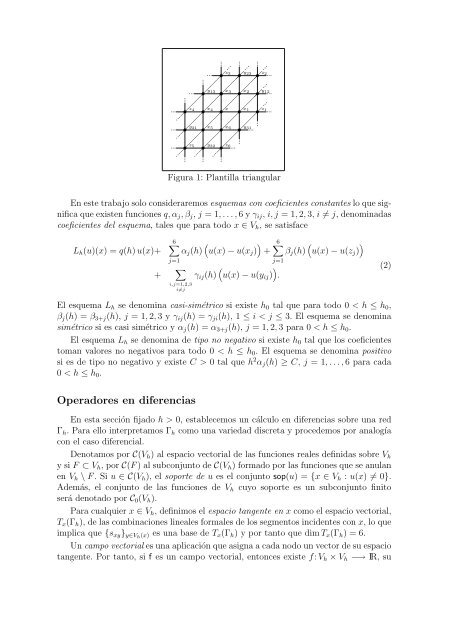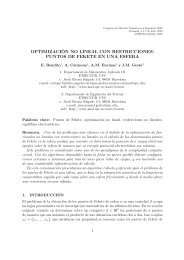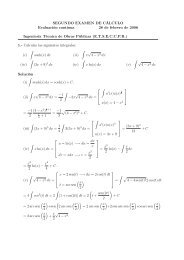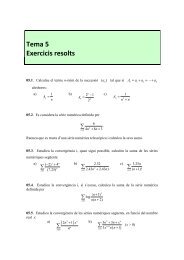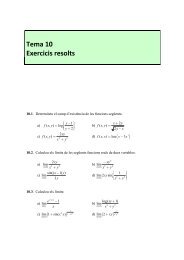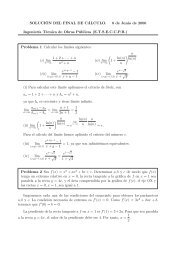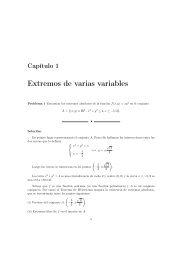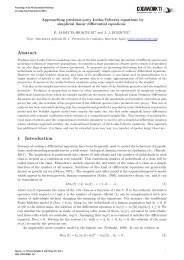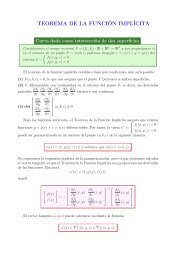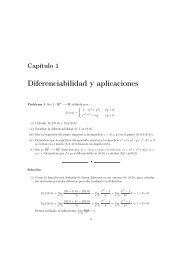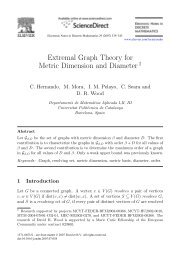Cálculo vectorial discreto para esquemas en diferencias sobre ...
Cálculo vectorial discreto para esquemas en diferencias sobre ...
Cálculo vectorial discreto para esquemas en diferencias sobre ...
Create successful ePaper yourself
Turn your PDF publications into a flip-book with our unique Google optimized e-Paper software.
♣ ♣ ♣<br />
♣♣♣ ♣♣♣ ♣♣♣<br />
♣ ♣ ♣ z 3 y 23 z 2 ♣ ♣ ♣<br />
♣<br />
♣♣♣<br />
♣ ♣ ♣ y 13<br />
x 3 x 2 y 12 ♣ ♣ ♣<br />
♣<br />
<br />
♣♣♣ <br />
♣♣♣<br />
♣ ♣ ♣ z 4 x 4 x x 1 z 1 ♣ ♣ ♣<br />
<br />
♣♣♣ ♣<br />
♣ ♣ ♣ y 21 x 5 x 6 y 31 ♣ ♣ ♣<br />
<br />
♣♣♣ <br />
♣♣♣ ♣♣♣ ♣<br />
♣ ♣ ♣ z 5 y 32 z 6 ♣ ♣ ♣<br />
♣ ♣ ♣<br />
Figura 1: Plantilla triangular<br />
En este trabajo solo consideraremos <strong>esquemas</strong> con coefici<strong>en</strong>tes constantes lo que significa<br />
que exist<strong>en</strong> funciones q, α j , β j , j = 1, . . . , 6 y γ ij , i, j = 1, 2, 3, i ≠ j, d<strong>en</strong>ominadas<br />
coefici<strong>en</strong>tes del esquema, tales que <strong>para</strong> todo x ∈ V h , se satisface<br />
L h (u)(x) = q(h) u(x)+<br />
+<br />
6∑<br />
α j (h) ( u(x) − u(x j ) ) 6∑<br />
+ β j (h) ( u(x) − u(z j ) )<br />
j=1<br />
j=1<br />
∑<br />
γ ij (h) ( u(x) − u(y ij ) ) .<br />
i,j=1,2,3<br />
i≠j<br />
(2)<br />
El esquema L h se d<strong>en</strong>omina casi-simétrico si existe h 0 tal que <strong>para</strong> todo 0 < h ≤ h 0 ,<br />
β j (h) = β 3+j (h), j = 1, 2, 3 y γ ij (h) = γ ji (h), 1 ≤ i < j ≤ 3. El esquema se d<strong>en</strong>omina<br />
simétrico si es casi simétrico y α j (h) = α 3+j (h), j = 1, 2, 3 <strong>para</strong> 0 < h ≤ h 0 .<br />
El esquema L h se d<strong>en</strong>omina de tipo no negativo si existe h 0 tal que los coefici<strong>en</strong>tes<br />
toman valores no negativos <strong>para</strong> todo 0 < h ≤ h 0 . El esquema se d<strong>en</strong>omina positivo<br />
si es de tipo no negativo y existe C > 0 tal que h 2 α j (h) ≥ C, j = 1, . . . , 6 <strong>para</strong> cada<br />
0 < h ≤ h 0 .<br />
Operadores <strong>en</strong> difer<strong>en</strong>cias<br />
En esta sección fijado h > 0, establecemos un cálculo <strong>en</strong> difer<strong>en</strong>cias <strong>sobre</strong> una red<br />
Γ h . Para ello interpretamos Γ h como una variedad discreta y procedemos por analogía<br />
con el caso difer<strong>en</strong>cial.<br />
D<strong>en</strong>otamos por C(V h ) al espacio <strong>vectorial</strong> de las funciones reales definidas <strong>sobre</strong> V h<br />
y si F ⊂ V h , por C(F ) al subconjunto de C(V h ) formado por las funciones que se anulan<br />
<strong>en</strong> V h \ F . Si u ∈ C(V h ), el soporte de u es el conjunto sop(u) = {x ∈ V h : u(x) ≠ 0}.<br />
Además, el conjunto de las funciones de V h cuyo soporte es un subconjunto finito<br />
será d<strong>en</strong>otado por C 0 (V h ).<br />
Para cualquier x ∈ V h , definimos el espacio tang<strong>en</strong>te <strong>en</strong> x como el espacio <strong>vectorial</strong>,<br />
T x (Γ h ), de las combinaciones lineales formales de los segm<strong>en</strong>tos incid<strong>en</strong>tes con x, lo que<br />
implica que {s xy } y∈Vh (x) es una base de T x (Γ h ) y por tanto que dim T x (Γ h ) = 6.<br />
Un campo <strong>vectorial</strong> es una aplicación que asigna a cada nodo un vector de su espacio<br />
tang<strong>en</strong>te. Por tanto, si f es un campo <strong>vectorial</strong>, <strong>en</strong>tonces existe f: V h × V h −→ IR, su


